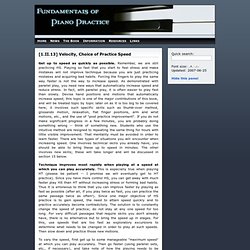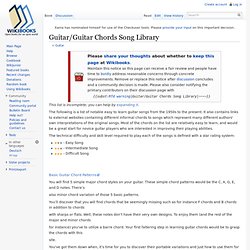

Fundamentals of Piano Practice: Velocity, Choice of Practice Speed. Get up to speed as quickly as possible.

Remember, we are still practicing HS. Playing so fast that you start to feel stress and make mistakes will not improve technique because you are just practicing mistakes and acquiring bad habits. Forcing the fingers to play the same way faster is not the way to increase speed. As demonstrated with parallel play, you need new ways that automatically increase speed and reduce stress. In fact, with parallel play, it is often easier to play fast than slowly. Technique improves most rapidly when playing at a speed at which you can play accurately. To vary the speed, first get up to some manageable "maximum speed" at which you can play accurately.
Increasing Speed. These results also provide the mathematical basis for explaining the well known trick of alternating fingers when playing the same note many times.

One might think at first that using just one finger would be easier and offer more control, but that note can be played repetitively faster by playing parallel using as many fingers as you can for that situation, than playing serially. The need for parallel play also singles out trills as a particularly difficult challenge to play fast because trills must in general be executed with only two fingers. If you tried to trill with one finger, you will hit a speed wall at, say, speed M; if you trill with two fingers, the speed wall will be at 2M (again, ignoring momentum balance). Does mathematics suggest any other way of attaining even higher speeds? Yes: phase truncation. What you can do is to lower the finger to play the note but then raise the finger only sufficiently to reset the repetition mechanism, before playing the next note. Piano World - Home of the world famous Piano Forums. The most piano information on the Web. Piano Lessons » Learn How To Play Piano Today! Exercise Your Finger Speed On The Piano.
Today I'm going to teach you a few finger exercises to help you build up speed and dexterity on the piano.

Let's start our finger exercise in that old standby, C Major. With whatever hand you choose to start with, play the first five notes of the scale, using all five fingers. Work your way from C to G, then back down again. Don't play as fast as you can just yet. Start off nice and slow and make sure that all of the notes are the same volume. Now let's move on to a full scale, say the F major scale. The last finger exercise I am going to talk about is arpeggios. Whatever methods you chose for finger practice, remember that starting off slow and building speed is the proper way to insure that you aren't learning bad habits. For the next lesson, I recommend you check out this Medley Of Famous Piano Songs. Guitar lessons, music news and guitar reviews and gear reviews. Guitar/Guitar Chords Song Library.
The following is a list of notable easy to learn guitar songs from the 1950s to the present.

It also contains links to external websites containing different informal chords to songs which represent many different authors' own interpretations of the original songs. Most of the chords on the list are relatively easy to learn, and would be a great start for novice guitar players who are interested in improving their playing abilities. The technical difficulty and skill level required to play each of the songs is defined with a star rating system: - Easy Song - Intermediate Song - Difficult Song Basic Guitar Chord Patterns You will find 5 simple major chord styles on your guitar. Also minor chord variation of those 5 basic patterns. You’ll discover that you will find chords that be seemingly missing such as for instance F chords and B chords in addition to chords with sharps or flats. For instance) you've to utilize a barre chord. Site. The 5 Essential Major Chord Patterns.